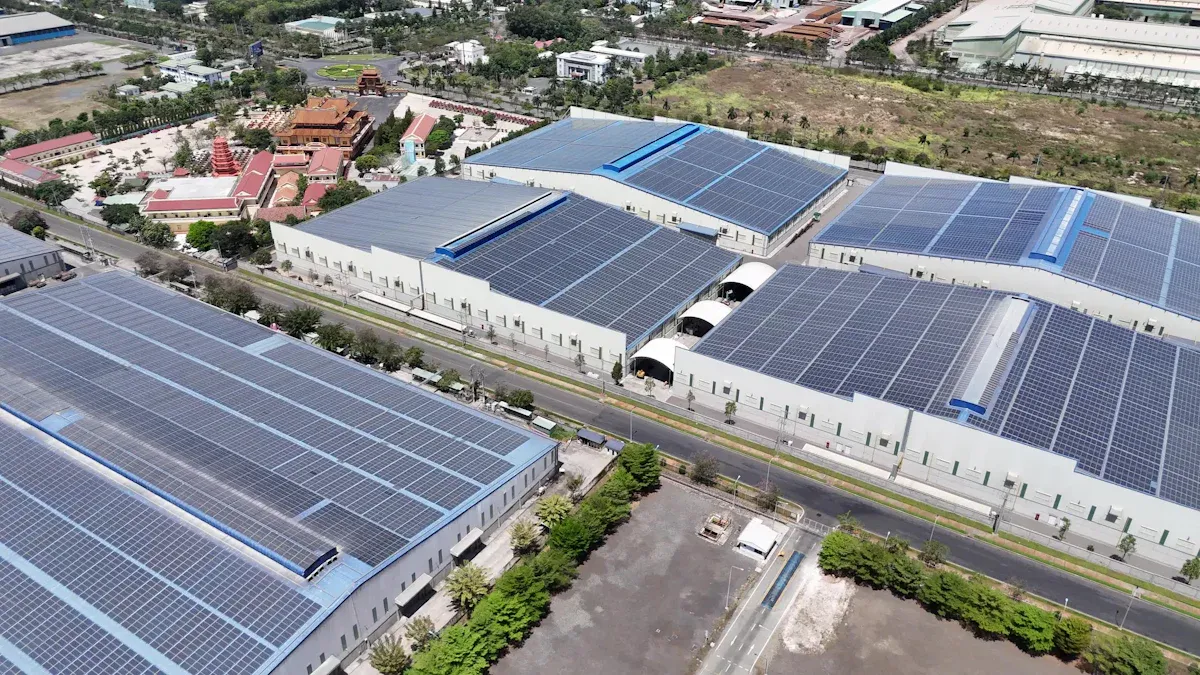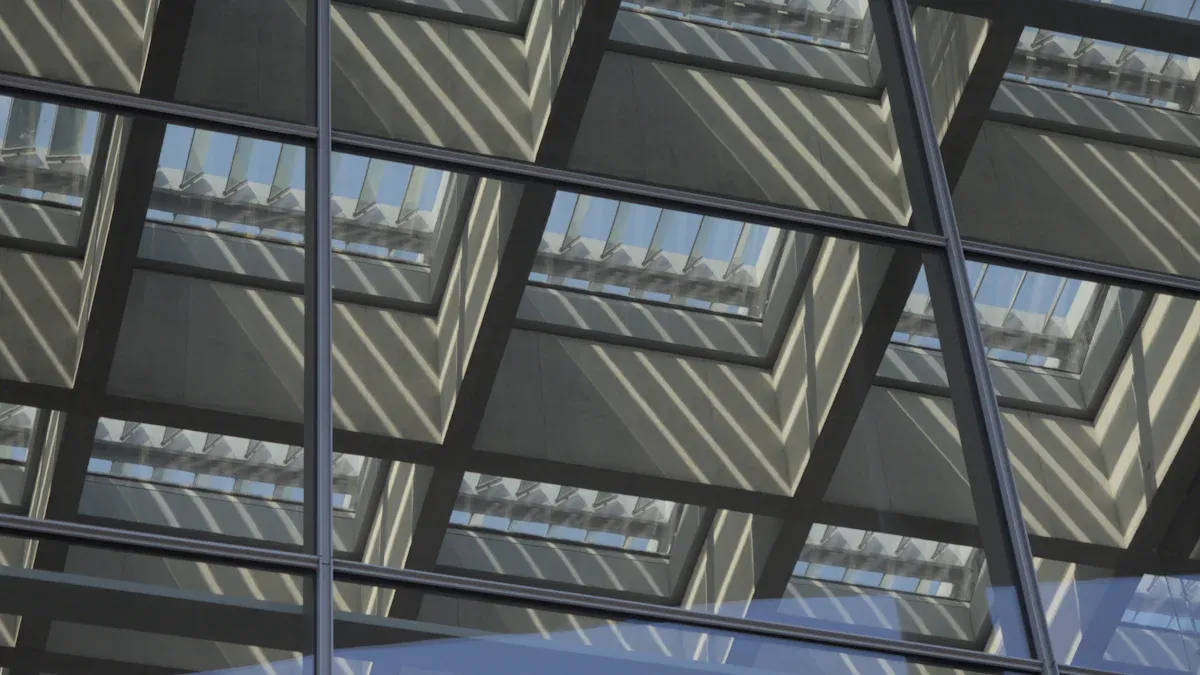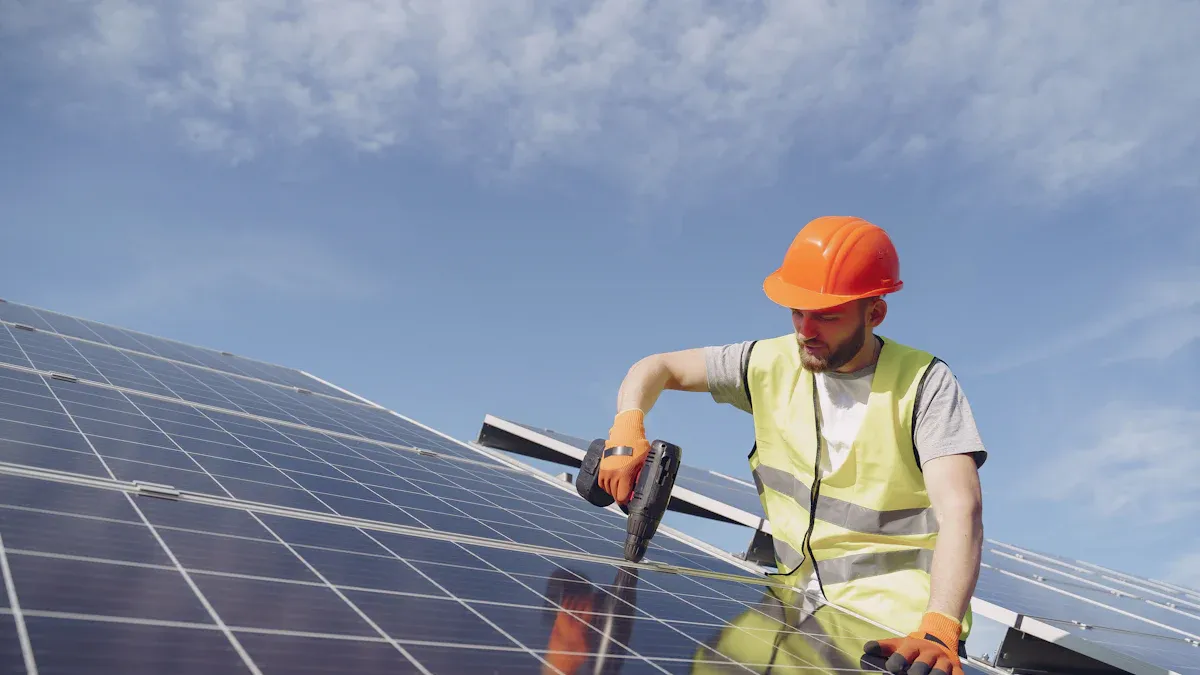How to reduce 30% installation cost using modular steel structure for PV panel in distributed photovoltaic boom

You can reduce installation costs by up to 30% when you use a modular Steel Structure for PV Panel projects. This approach gives you faster installation and standardization, which leads to less labor and material waste. You also benefit from economies of scale and lower administrative expenses. Distributed photovoltaic projects become easier to scale, making this method ideal for large or small installations.
Key Takeaways
Modular steel structures cut installation costs by up to 30% through faster assembly and less material waste.
Prefabricated modules reduce on-site labor, speed up construction, and improve safety.
Standardized designs ensure high quality, simplify permits, and lower maintenance needs.
Using corrosion-resistant steel and smart coatings extends the lifespan and durability of PV systems.
Careful site assessment and proper planning help avoid problems and make installations more efficient.
Steel Structure for PV Panel

Modular Design
When you choose a modular design for your Steel Structure for PV Panel, you gain several advantages. Modular systems use prefabricated components that manufacturers assemble off-site. This approach lets you reduce on-site construction time and avoid weather delays. You can transport these modules easily and install them quickly, which helps you meet tight project deadlines.
You will find that modular steel structures offer strength and durability. ZAM steel, a hot-dip Zinc-Aluminum-Magnesium alloy-coated steel, stands out for its corrosion resistance and long lifespan. This material gives you a cost-effective alternative to traditional galvanized steel. With modular systems, you can also adjust tilt angles to capture more solar energy throughout the year.
Modular buildings support scalability. You can expand your distributed photovoltaic project by repeating familiar designs.
Off-site prefabrication protects workers and reduces construction pauses.
Standardized layouts help your team work efficiently across different sites.
Tip: Modular designs allow you to adapt quickly to changing site needs, making your PV installations more flexible and future-proof.
Standardization
Standardization in your Steel Structure for PV Panel project brings consistency and reliability. When you use standardized modules, you benefit from factory-level inspections. These inspections ensure each module meets strict quality standards before it arrives at your site. This process reduces installation errors and helps you avoid costly rework.
You also save time because standardized modules streamline regulatory compliance. Preapproved designs make permitting and inspection faster. You can even fabricate modules while preparing your site, which shortens your overall project timeline.
The controlled factory environment ensures consistent workmanship. Specialized labor and stable conditions minimize defects. Standardized interfaces and connection points make assembly easier and reduce mistakes.
Here’s how modular steel structures compare to traditional mounting systems:
Aspect | Modular Steel Structures | Traditional Mounting Systems |
|---|---|---|
Recyclability | Lower recyclability | |
Durability & Lifespan | 20+ years, corrosion resistant | 10-15 years, more prone to damage |
Maintenance | Low | Higher |
Adaptability | High modularity, easy customization | Less adaptable |
Environmental Benefits | Reduces waste, supports sustainability | More waste, shorter lifespan |
You can see that modular steel structures not only improve efficiency but also support your sustainability goals.
Cost Reduction
Labor Savings
You can achieve significant labor savings by choosing modular steel structures for your PV panel installations. Modular systems use pre-assembled components, which means you spend less time on-site. You do not need to handle as many parts or perform complex assembly steps. This approach reduces the need for skilled labor and allows smaller teams to complete installations quickly.
Integrated or rail-less racking systems eliminate many hardware components, making installation faster.
Minimal base preparation and fewer attachments simplify the process, so your crew works more efficiently.
Simplified electrical connections, such as grounding and combiner boxes, further reduce labor time.
You can often complete installations in a single day, especially for smaller distributed projects.
Modular steel structures also remove the need for heavy civil engineering work. You avoid digging trenches or pouring large amounts of concrete. Workers can install panels at ground level, which improves safety and speeds up the process. These factors can cut construction time by up to 50%. Reports from the National Renewable Energy Laboratory show that automation and preassembly can improve labor and hardware costs by 30% to 40%. This improvement reflects real reductions in labor hours and overall project costs.
Tip: Training your team on standardized modular systems can further boost efficiency and reduce errors during installation.
Material and Logistics
Modular steel structures help you save on material and logistics costs through efficient design and prefabrication. High-strength steel reduces the amount of material needed for foundations and supports. Up to 85% of the structure can be prefabricated in a factory, which means you use materials more efficiently and generate less waste.
Aspect | Benefit |
|---|---|
Material Usage | High-strength steel lowers foundation loads and saves material. |
Prefabrication Level | Up to 85% prefabrication reduces on-site labor and waste. |
Modular Division | Modules sized for transport improve factory efficiency and lower shipping costs. |
Transportation Logistics | Modules fit standard trailers, allowing efficient and secure long-distance transport. |
On-site Assembly Efficiency | Rapid assembly with small teams reduces construction time and costs. |
Overall Impact | Efficient design and transport lower both material and logistics expenses. |
Factory-controlled production ensures precise measurements and optimized material use. This process reduces overages and minimizes jobsite waste. Research shows that pre-assembly in modular construction leads to less material waste because factories recycle materials and control inventory. You also benefit from less site disturbance and tighter construction, which further reduces waste.
Note: Efficient logistics planning with modular systems can help you avoid delays and keep your project on schedule.
Administrative Efficiency
You can streamline administrative tasks by using modular steel structures. Standardized designs make permitting and inspection much faster. Regulatory agencies often preapprove modular systems, so you spend less time waiting for approvals. Factory inspections ensure each module meets quality standards before it arrives on-site, reducing the risk of costly rework.
Standardized modules simplify documentation and compliance.
Pre-approved designs speed up permitting and inspection.
Factory quality control reduces the need for on-site corrections.
You also benefit from economies of scale. When you use the same Steel Structure for PV Panel across multiple projects, you can order in bulk and negotiate better prices. This approach lowers your administrative workload and helps you manage multiple sites more efficiently.
Tip: Keep detailed records of your modular components and approvals to make future projects even smoother.
Implementation Steps

Project Assessment
You should start with a thorough project assessment. This step helps you decide if a modular steel structure fits your PV panel installation.
Check the structural integrity and load capacity of your site. Make sure the roof or ground can support the weight of the panels and steel frames.
Evaluate environmental factors like wind, snow, hail, sandstorms, dust, temperature swings, humidity, rainfall, and corrosion risks.
Use protective coatings such as zinc-dust primers or Magnesium-Aluminum-Zinc alloys to boost durability.
Consider how modular and adaptable the steel structure is for your site and future upgrades.
Confirm compliance with international standards like ISO, IEC, or UL for safety and quality.
Assess the roof’s load-bearing ability and waterproofing. Try to minimize roof penetrations.
Add smart monitoring systems to track structural health and spot issues early.
Choose steel grades and reinforcements that match your local climate, such as marine-grade steel for coastal areas.
Tip: Use shading analysis tools to avoid obstructions and maximize solar energy capture.
System Selection
Selecting the right modular steel system depends on several criteria. The table below shows key factors and examples:
Selection Criteria | Explanation | Example Case Study |
|---|---|---|
Soil Conditions | Geotechnical assessment determines suitable pile material; steel preferred in soft soils, concrete in rocky terrain. | Concrete piles used in mountainous rocky terrain for high compressive strength. |
Load-Bearing Capacity | High load requirements favor concrete or composite piles; smaller loads may use steel or timber. | Steel piles used in coastal area with high wind loads for flexibility and strength. |
Environmental Factors | Corrosion resistance, seismic activity, groundwater levels influence material choice. | Composite piles used in earthquake-prone area to absorb seismic forces. |
Cost and Local Availability | Material choice influenced by local availability and economic considerations. | Timber piles used in low-impact or environmentally sensitive projects. |
You should match your system to your site’s unique needs for best results.
Installation Process
You can speed up installation by using modular steel structures. Prefabricated modules arrive ready for quick assembly.
Use small teams to move and connect modules, which reduces labor time.
Follow the manufacturer’s instructions for safe and efficient assembly.
Secure all connections and check alignment as you go.
Install electrical components and grounding systems as part of the modular process.
Note: Prefabrication and clear instructions help you avoid delays and reduce on-site waste.
Quality Control
Quality control ensures your PV system lasts for years.
Inspect plans and materials before construction to meet building codes.
Check installation quality after assembly and confirm safety standards.
Monitor the project with audits and real-time reporting tools like FTQ360.
Use inspection checklists and mobile devices to catch issues early.
Choose modular steel panels with advanced coatings and weatherproof membranes for extra durability.
You can maintain high standards and avoid common defects by following these steps.
Case Studies
Real-World Examples
You can see the impact of modular construction in many real-world projects. When you use a Steel Structure for PV Panel, you benefit from several advanced technologies that improve both speed and quality. Here are some key findings from recent projects:
Building Information Modeling (BIM) helps you keep your project on budget and on schedule. BIM reduces onsite time and manages costs.
Artificial Intelligence (AI) improves your project estimation and helps you avoid risks.
Augmented Reality (AR) gives your team real-time instructions during assembly. This reduces errors and speeds up construction.
3D printing allows you to produce components quickly and with high precision. You need fewer workers, which lowers your costs.
Drones help you inspect sites faster and plan efficient transportation routes for your modular components.
Modular construction can cut project timelines by up to 50%. You can manufacture modules off-site while you prepare the site.
Factory-built modules pass strict quality checks. This reduces defects and weather delays.
The Wuhan Thunder God Mountain Hospital was built in just 10 days using modular steel structures. This shows how fast you can deploy these systems.
Note: You should plan transportation and site preparation carefully. These steps are important, but they do not cancel out the time and cost savings.
Cost Comparison
When you compare modular steel structures to traditional mounting systems, you find clear cost advantages. Modular ballasted systems are affordable and easy to install. You can use them on flat or slightly sloped roofs without making holes. Rail-less mounting systems save you money on materials and speed up installation, but they may need more skilled workers.
System Type | Installation Speed | Material Cost | Labor Cost | Maintenance | Total Cost of Ownership |
|---|---|---|---|---|---|
Modular Steel Structure | Fast | Lower | Lower | Low | Lower |
Traditional Mounting | Slower | Higher | Higher | Higher | Higher |
You should look at the total cost of ownership, not just the upfront price. Modular systems reduce labor and material costs, and they also lower maintenance expenses over time. This means you can achieve up to 30% installation cost reduction when you choose modular solutions for your distributed photovoltaic projects.
Considerations
Site Factors
You need to evaluate several site factors before installing modular steel structures for PV panels. Start by checking the load-bearing capacity of your roof or ground. Not all new roofs can support solar panels, so always verify structural strength. Ballasted PV systems may seem easy, but they add weight that older roofs might not handle. Early consultation with a structural engineer helps you avoid costly surprises.
Environmental conditions also play a big role. You should select corrosion-resistant materials like marine-grade steel if your site faces salt exposure, high humidity, or extreme weather. Regular inspections and protective coatings help prevent rust and extend the lifespan of your structure. Snow and ice loads require special attention in cold climates. Use anti-snow coatings and plan for regular snow removal to avoid stress on the steel frame.
Maintenance is key for long-term performance. You should:
Inspect and reapply protective coatings to prevent corrosion.
Use locking fasteners and through bolting to keep connections tight.
Optimize support placement and use bracing for stability.
Monitor for ground movement and anchor the structure securely.
Prepare for storms by tightening connections and inspecting anchors.
Tip: Professional engineering advice ensures your design meets local codes and environmental needs.
Challenges and Solutions
You may face unique challenges when using modular steel structures in distributed PV projects. The table below shows real-world examples and how teams solved these issues:
Project / Location | Challenges | Solutions |
|---|---|---|
Southern New Hampshire University (Manchester, NH) | Extreme snow loads, high winds, limited space, need to attach to existing columns | Used QuadPod modular steel structure, pre-assembled on ground, crane-lifted, adjustable span, lightweight truss design |
Amphenol Solar Project (Sidney, NY) | Brownfield site, foundation limits, floodplain, weak soils | Hybrid racking, ballasted system on existing slabs, deep driven piles, adapted racking for site conditions |
You might also worry about the mechanical vulnerability of large PV modules with thinner glass. Steel frames help reduce breakage risk during shipping and installation. Domestic steel avoids tariffs and supply chain delays, making your project more reliable and cost-effective.
Some people think modular steel structures lack quality or flexibility. Modern systems prove otherwise. Projects like Bethany Terraces in Brooklyn show that modular steel can meet high energy standards and support creative designs. Prefabricated steel structures now offer style, durability, and customization.
Note: Regular maintenance and early engineering input help you overcome most challenges and ensure your PV system lasts for decades.
You can achieve up to 30% installation cost savings by choosing a Steel Structure for PV Panel. Modular systems give you faster assembly, less waste, and easier project management. You gain flexibility and long-term durability for distributed photovoltaic projects. For more guidance, explore these resources:
JB STEEL® offers guides on modular steel buildings, customization, and sustainability.
The Whole Building Design Guide covers PV system components, procurement, and maintenance.
These tools help you make informed decisions and maximize your project’s success.
FAQ
What is a modular steel structure for PV panels?
A modular steel structure uses prefabricated steel parts to support solar panels. You can assemble these parts quickly on-site. This method saves time and reduces errors compared to traditional construction.
How does modular construction reduce installation costs?
You save money because modular systems use less labor and material. Factories make the parts with precision, so you waste fewer resources. You also finish projects faster, which lowers your overall expenses.
Can you use modular steel structures on any site?
You can use modular steel structures on most sites. Always check the ground or roof strength first. Some locations may need special coatings or extra supports to handle weather or soil conditions.
Are modular steel structures durable?
Yes, modular steel structures last a long time. Many use corrosion-resistant coatings like ZAM steel. You get strong support for your solar panels and less maintenance over the years.
See Also
Solar Energy Storage Solutions Designed For Telecom Cabinets
Telecom Cabinets Featuring Grid-Tied Solar Inverter And Batteries
Enhancing Outdoor Cabinets With Efficient Power Cooling Monitoring
Guide To Choosing And Installing Pole-Mounted Telecom Cabinets Safely
ESTEL’s Smart Microgrid Telecom Cabinet Energy Storage Solution
CALL US DIRECTLY
86-13752765943
3A-8, SHUIWAN 1979 SQUARE (PHASE II), NO.111, TAIZI ROAD,SHUIWAN COMMUNITY, ZHAOSHANG STREET, NANSHAN DISTRICT, SHENZHEN, GUANGDONG, CHINA


